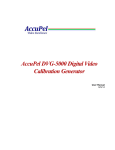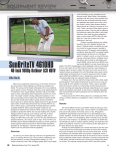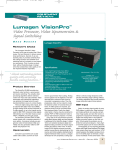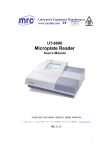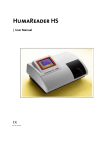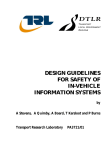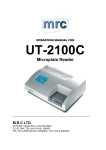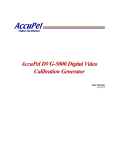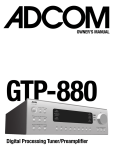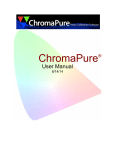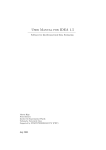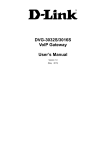Download Motion User Manual
Transcript
DVG-5000 DIGITAL VIDEO GENERATOR MOTION PATTERN OPTION USER MANUAL AccuPel DVG-5000 Documentation – Motion Pattern Option Manual DVG-5000 Motion Pattern Option DVG-5000 DIGITAL VIDEO GENERATOR MOTION PATTERN OPTION USER MANUAL Motion Pattern Option for the AccuPel DVG-5000 Digital Video Calibration Generator USER MANUAL Version 1.00 2 DVG-5000 DIGITAL VIDEO GENERATOR MOTION PATTERN OPTION USER MANUAL Table of Contents DVG-5000 MOTION PATTERN OPTION OVERVIEW ................................................................................... 4 ACCESSING THE MOTION PATTERNS ......................................................................................................... 5 Display the Current Motion Pattern .................................................................................................... 5 MOTION PATTERN MENU ........................................................................................................................... 5 Display the Motion Pattern Menu ....................................................................................................... 5 Hide the Motion Pattern Menu .......................................................................................................... 5 MOTION PATTERN MENU ITEMS ................................................................................................................ 5 Group ................................................................................................................................................. 5 Pattern ................................................................................................................................................. 6 HV Increment ..................................................................................................................................... 6 Cadence ............................................................................................................................................... 6 Cursors ................................................................................................................................................ 6 Units .................................................................................................................................................... 7 MOTION ITEMS IN THE MAIN OSD MENU .................................................................................................. 8 I–Motion ............................................................................................................................................. 8 Motion Pattern Colors ......................................................................................................................... 8 PATTERNS BY GROUP ................................................................................................................................. 8 Circular Zone Plates ............................................................................................................................ 8 Hyperbolic Zone Plates ....................................................................................................................... 8 Resolution Wedges ............................................................................................................................. 8 Cosine Balls ........................................................................................................................................ 8 Detail Discs ......................................................................................................................................... 8 Linear Frequency Sweeps ................................................................................................................... 8 INTRODUCTION TO VIDEO MOTION TESTING ............................................................................................. 9 Quantitative and Qualitative Testing .................................................................................................. 9 Spatio-temporal Frequency Domain ................................................................................................... 9 Spatial Frequency vs. Temporal Frequency........................................................................................ 9 Digital Video Structure & Sampling Frequency ................................................................................. 9 Nyquist Frequency ............................................................................................................................ 10 Frequency Replication &Aliasing .................................................................................................... 10 Spatial Frequency Response (MTF) & Effective Resolution ........................................................... 11 MOTION PATTERN NOTES ........................................................................................................................ 12 Zone Plates ........................................................................................................................................ 12 Circular Zone Plates ......................................................................................................................... 12 Hyperbolic Zone Plates ..................................................................................................................... 12 Resolution Wedges .......................................................................................................................... 12 Example - Measuring Effective Resolution with and without Motion ....................................... 12 Horizontal and Vertical Linear Frequency Sweeps ......................................................................... 13 Detail Discs ....................................................................................................................................... 13 Cosine Balls ..................................................................................................................................... 13 Standard-Definition vs. High-Definition Patterns ........................................................................... 13 Copyright 2011 by Display Calibrations, LLC AccuPel is a trademark of Display Calibrations, LLC. Specifications subject to change without notice. All Rights Reserved. 3 DVG-5000 DIGITAL VIDEO GENERATOR MOTION PATTERN OPTION USER MANUAL DVG-5000 Motion Pattern Overview The AccuPel DVG-5000 Motion Pattern Option adds a variety of Motion Patterns to the DVG-5000 Digital Video Calibration Generator that can be used to evaluate the effects of motion processing in a display or standalone video processor. Video without motion is simply a collection of still pictures. Static test patterns are essential for calibrating basic display parameters, but real-world video performance depends on how display technologies and video processing algorithms handle motion. The DVG-5000 Motion Patterns can be used to evaluate the performance of 480i, 576i, and 1080i deinterlacing, measure effective horizontal and vertical display resolution and spatial frequency response during motion, and reveal the artifacts of smooth motion frame-interpolation technologies on horizontal and vertical detail that are commonly used in flat panel displays and video projectors. The motion patterns also readily reveal the many possible effects of linear and non-linear video processing, including motion-induced contouring, at user selectable motion rates and angles. Motion Groups The Motion Patterns are divided into six (6) Motion Groups – Circular Zone Plates, Hyperbolic Zone Plates, Horizontal (H) & Vertical (V) Resolution Wedges, H & V Linear Frequency Sweeps, H & V Detail Discs, and Cosine Balls. Each Motion Group includes patterns of varying types and sizes to accommodate standarddefinition and high-definition video formats. The initial release includes 70 Motion Patterns. Motion Pattern Selection All Motion Patterns are selected from the Motion Pattern OSD (On-screen Display) Menu, which is available whenever the current Motion Pattern is selected in the DVG-5000’s Special Group Menu. The current Motion Pattern is the last pattern in the Special Group. User Selectable Motion Rates The horizontal and vertical continuous motion rates can be independently selected in pixels per frame (or field) and lines per frame (or field) respectively. That also allows the user to select the on-screen angular path of motion. Film Cadence Motion The field motion cadence for 480i, 576i, and 1080i formats can be selected as 1-1, 2-2, or 3-2. The former produces native video camera interlaced-video motion, while the latter produces the film cadences used for 50 Hz and 60 Hz interlaced video respectively. Active Motion Resolution/Frequency Cursors Horizontal, vertical, and radial cursors can be enabled that ride on the moving patterns to provide real time measurement of horizontal and vertical resolution and spatial frequency response as the user changes motion rates. Cursor readout is selectable in resolution units of Lines/picture width and Lines/picture height (TVL). Frequency units of Cycles/picture width, cycles/picture height, and % of Nyquist Frequency are selectable. Motion Pattern Formats & Colors All motion patterns are available for all DVG-5000 2D video formats and for all 3D Frame Packing video formats. The motion patterns are available in YCbCr 4:2:2/YCbCr 4:4:4 grayscale, and RGB-Video/RGB-PC grayscale, primary, and complementary colors. 4 DVG-5000 DIGITAL VIDEO GENERATOR MOTION PATTERN OPTION USER MANUAL Access the Motion Patterns Display the Current Motion Pattern – The currently selected Motion Pattern is accessible in the DVG-5000 Special Patterns Group. The initial Motion Pattern after a DVG-5000 power-up is a Hyperbolic Zone Plate. To display the current Motion Pattern: 1) Select the Special Patterns Group - Press the Special button on the DVG-5000 remote control, or use the Group button on the remote control or the DVG-5000 front panel to advance to the Special Group. 2) Select the current Motion Pattern – The current Motion Pattern is the last pattern in the Special Patterns group. Use the Pattern button on the DVG-5000 remote control, or the Prior and Next buttons on the DVG-5000 front panel to advance forward or backward through the Special Pattern group to display the current Motion Pattern. Motion Pattern Menu Display the Motion Pattern Menu – When the Motion Pattern is selected in the Special Group the Motion Pattern Menu will appear on screen and remain until the user turns it off or the main OSD menu is selected. Press the Info button to return to the Motion Pattern Menu if the main OSD menu is or has been displayed. Hide the Motion Pattern Menu – Press the Info button on the remote control to hide the Motion Pattern Menu during testing, or to turn it back on after it has been hidden. Technical Note: Menus are a static part of the image that must be processed by the display in addition to the moving pattern. It can be instructive to view how the display processes the combined static and moving image features. But to observe how the display processes only the moving image turn off all menus. Motion Pattern Menu Items The left column of the Motion Pattern Menu contains the six (6) top-level menu items – Group, Pattern, HV Incr, Cadence, Cursors, and Units. The selected menu item is highlighted in green. Select a different menu item by pressing the remote control Up or Down cursor keys whenever a Motion Pattern Menu item in the left column is highlighted in green. The menu items’ current settings are displayed in the middle column opposite each menu item. The third column contains remote control button reminders. Group – Selects a Motion Pattern Group – Circular ZP (Zone Plate), Hyperbolic ZP, Resolution (Wedges), Cosine Ball, Detail Disc, and Linear Frequency (Sweeps). The selected Motion Pattern Group is shown in the center column. Use the Left and Right cursor keys to select a Motion Pattern group whenever Group is highlighted in green. 5 DVG-5000 DIGITAL VIDEO GENERATOR MOTION PATTERN OPTION USER MANUAL Pattern – Selects a Motion Pattern within a Motion Pattern Group - The selected Motion Pattern is shown in the center column. Use the Left and Right cursor keys to select a Motion Pattern whenever Pattern is highlighted in green. HV Incr – Selects the Horizontal and Vertical Motion Increments – The Hxx (horizontal) and Vxx (vertical) motion increments are shown in the center column. Use the Left and Right cursor keys to select the Hxx or Vxx motion increment items. Use the Up and Down cursor keys to increment or decrement a highlighted Hxx and Vxx motion increment. Movement begins/changes immediately when the Hxx or Vxx motion increments are set to non-zero values. The Horizontal and Vertical motion increments are pixels per frame (or field) and lines per frame (or field) respectively. The following remote control keys can also be used to change movement. Enter - Run/Stop Movement – Press the remote control Enter button to start or stop movement, even when the Motion Pattern menu is turned off. SoG – Press SoG to position the pattern to center of the screen grid while the pattern is stopped or moving, even when the Motion Pattern menu is turned off. If the pattern is moving it will continue to move. Cadence – Selects the field cadence for interlaced video formats – The selected field cadence is shown in the center column. The selection is grayed out for progressive video formats. Use the Left and Right cursor keys to select Fields 1-1, Fields 2-2, or Fields 3-2 for interlaced video formats. Fields 1-1 produces normal interlaced video camera images where movement occurs between each video field. Fields 2-2 produces the 2-2 field pull-down process used to transfer 24 Hz motion picture film to 50 Hz video formats, where movement only occurs after 2 video fields. Fields 3-2 produces the 3-2 (2-3) field pull-down process used to transfer 24 Hz motion picture film to 60 Hz video formats, where movement alternately occurs after 2 or 3 video fields. Cursors – Enables or disables Active Cursors on Motion Patterns – The horizontal, vertical and radial spatial frequency (Fh, Fv, and Fr) or spatial resolution (Rh, Rv, and Rr) cursor values are displayed as appropriate for the selected motion pattern. The horizontal and vertical spatial frequency (or resolution) is constant along the entire cursor line. The radial cursor value represents the spatial frequency (or resolution) at the intersection of the cursor lines. Use the Left and Right cursor keys to select or disable the active cursors whenever Cursors is highlighted in green. The following remote control keys can be used to change the Active Cursor positions on the moving patterns. Up / Down – Single-steps the cursor position manually – Moves the cursor position slowly for fine adjustment on each push of the Up or Down cursor buttons. The Fh or Fv cursor value must be selected (highlighted). Pos / Neg – Automatically changes the cursor position in larger increments/decrements – Moves the cursor position quickly for coarse adjustment. Press the Pos or Neg button once to begin movement and press again to stop movement. The Fh or Fv cursor value must be selected (highlighted). Func - SoG – Zeros the cursor positions – This remote control button sequence moves the cursor positions to the origin where their spatial frequency values are zero, even when the Motion Pattern menu is turned off, and even when the cursors are not selected. Func - Info – Turns the cursors on or off – This remote control button sequence turns the cursors on or off, even when the Motion Pattern menu is turned off, and even when the cursors are not selected. 6 DVG-5000 DIGITAL VIDEO GENERATOR MOTION PATTERN OPTION USER MANUAL Units – The unit for each cursor value is shown just below each cursor value whenever Cursors are enabled. The Units menu item and the cursor units are not displayed when the Cursors are Off. Use the Left and Right cursor keys to change the resolution and frequency units whenever Units is highlighted in green. Four (4) sets of units are selectable. Spatial Resolution Units Cursor Rh Rv Units (set 1) L/PW L/PH L/PW Units (set 2) TVL TVL TVL Rr Spatial Frequency Units Cursor Fh Fv Units (set 3) %Nyq %Nyq %Nyq Units (set 4) C/PW C/PH C/PW Fr Cursor Labels Rh, Rv, Rr = Horizontal, vertical, and radial spatial resolution cursors Fh, Fv, Fr = Horizontal, vertical, and radial spatial frequency cursors Resolution Units L/PW = Lines per Picture Width L/PH = Lines per Picture Height TVL = TV Lines (L/PH) Frequency Units %Nyq = % of Nyquist Frequency C/PW = Cycles per Picture Width C/PH = Cycles per Picture Height Notes: 1) Effective video resolution is numerically the maximum TOTAL number of light and dark lines that can be individually discerned per picture width or picture height. This differs from photography where image and lens resolution is usually stated in terms of line-pairs rather than total lines. 2) TVL (TV Lines) is the traditional unit for specifying effective display resolution for both horizontal and vertical resolution. TVL is equivalent to L/PH. The horizontal spatial resolution in TVL (L/PH) is therefore the L/PW divided by the display aspect ratio (16/9 = 1.777 for HD). 3) The Nyquist spatial frequency is the absolute maximum spatial frequency that can be represented in an image and is therefore equivalent to one-half of the spatial sampling rates. The horizontal Nyquist frequency is one-half the total Pixels/PW. The vertical Nyquist frequency is one-half the total Lines/PH. Selecting Cursor Span (ALT-SoG) – Cursor values increase as the cursors move in any direction away from the pattern origin (you can set the cursors to the origin by pressing the Func-SoG key sequence). When the cursors reach the Nyquist Frequency the values then decrease until the cursor reaches the Sampling Frequency location (twice the Nyquist Frequency). This matches the displayed cursor values to the image spatial frequencies (in the absence of aliasing frequencies). See the discussion of Frequency Replication & Aliasing in the Technical Concepts section of this manual. The span of the cursor values can be doubled to twice the Nyquist Frequency by pressing the ALT-SoG key sequence. This may be helpful for understanding the Frequency Replication concept. Press the ALT-SoG key sequence again to restore the default single Nyquist Frequency cursor values span. 7 DVG-5000 DIGITAL VIDEO GENERATOR MOTION PATTERN OPTION USER MANUAL Motion Items in the Main OSD Menu I-Motion (in Sync menu) – Determines how interlaced fields sync to pattern frequencies and motion. Phase-Lock – When an odd number of lines of vertical movement per field are selected, horizontal pattern lines at the Nyquist frequency will always be displayed in the interlaced fields. Random – When an odd number of lines of vertical movement per field is selected, horizontal pattern lines at the Nyquist frequency will be randomly displayed or not displayed in interlaced fields. Motion Pattern Colors (in Output/Channels menu) – Grayscale, Primary (Red, Green, Blue), and Complementary (Yellow, Cyan, Magenta) colors can be selected for RGB-Video and RGB-PC output signal types. Motion patterns for YCbCr 4:2:2 and YCbCr 4:4:4 output signal types are grayscale only. Patterns by Group Circular ZP (Zone Plate) (12) – Tiny 71% Nyquist Zone Plate, Tiny Nyquist (Zone Plate), Tiny ZP (Zone Plate) Field, Small 71% Nyquist Zone Plate, Small Nyquist (Zone Plate), Small ZP (Zone Plate) Field, Medium 71% Nyquist Zone Plate, Medium Nyquist (Zone Plate), Medium ZP (Zone Plate) Field, Large 71% Nyquist Zone Plate, Large Nyquist (Zone Plate), Large ZP (Zone Plate) Field Hyperbolic ZP (Zone Plate) (5) – Zone Plate 1, Zone Plate 2, Zone Plate 3, Zone Plate 4, Zone Plate 5 Resolution (Wedge) (15) – V Res 1 Left, V Res 2 Left, V Res 3 Left, V Res 1 Right, V Res 2 Right, V Res 3 Right, H Res 1 Top, H Res 2 Top, H Res 3 Top, H Res 1 Bottom, H Res 2 Bottom, H Res 3 Bottom, HV Res 1, HV Res 2, HV Res 3 Cosine Ball (6) – Ball 91, Ball 128, Ball 181, Ball 256, Ball 362, Ball 512 Detail Disc (16) – H Slice 1, H Slice 2, H Slice 4, H Slice 8, V Slice 1, V Slice 2, V Slice 4, V Slice 8, Squares 1, Squares 2, Squares 4, Squares 8, Checker 1, Checker 2, Checker 4, Checker 8 Linear Frequency (Sweep) (16) – H1 Rect (Rectangle), H1 Field, H2 Rect, H2 Field, H3 Rect, H3 Field, H4 Rect, H4 Field, V1 Rect, V1 Field, V2 Rect, V2 Field, V3 Rect, V3 Field, V4 Rect, V4 Field 8 DVG-5000 DIGITAL VIDEO GENERATOR MOTION PATTERN OPTION USER MANUAL Introduction to Video Motion Testing Quantitative and Qualitative Testing Motion patterns are an essential tool for assessing video performance. The optional AccuPel DVG-5000 motion patterns are digitally generated in real-time using mathematical algorithms that produce perfectly uniform spatial frequency characteristics for the measurement and evaluation of displays and video processors. The digital patterns are generated using the native sample rates of each user-selected video format so there is no resampling of stored patterns, and no scaling applied to the patterns, which would degrade their spatial frequency response and introduce artifacts into the test patterns. Experienced video engineers will recognize the spatial frequency characteristics and various non-linear artifacts of particular video processing algorithms and digital processing techniques used in displays and video processors. Video processing implementations can be tuned to minimize those artifacts and the loss of spatial frequency response (resolution) using the supplied zone plates and motion patterns. Detailed quantitative analysis of motion-adaptive and motion-compensated video signal processing requires an extensive understanding of those algorithms in the spatio-temporal frequency domain, which is beyond the scope of this User Manual. However, quantitative measurements of effective horizontal and vertical display resolution versus motion rate and direction can easily be made to characterize and compare displays, and to optimize a display’s video processing settings (such as sharpness, detail enhancement, smooth-motion modes, deinterlacing modes, and overscan). In addition, qualitative observations will reveal linear and non-linear processing artifacts that can be used to optimally adjust or rank the quality of video processing in displays and standalone video processors. Qualitative analysis is readily accessible for video enthusiasts and product evaluators, and with experience can be correlated to typical video image problems observed in common source material. Frequency Domain Concepts Spatio-temporal frequency domain – Video signals represent discrete two-dimensional images (fields or frames) that can only change at fixed periodic intervals. Hence, video signals are actually a function of three dimensions – horizontal (x) and vertical (y) position (which define an image within a field or frame), and discrete instances in time (t). Consequently, detailed analysis of video signals and video signal processing can get complex because signals and moving images are functions of a 3-dimensional spatio-temporal frequency domain. Spatial Frequency vs. Temporal Frequency - Temporal frequency refers to the number of magnitude cycles that occur in a defined interval of time. Analog audio signals are a common example of temporal frequency. The amplitude of an audio signal may swing between high and low excursions 1000 times per second. In that case the signal frequency is 1000 Hz (1 kHz), where Hz (Hertz) is the unit cycles per second. Video signals and pictures are defined by the composition of frame (or field) images and how they change in time from frame to frame (or field to field). Individual field or frame images can be characterized by spatial frequencies, which are the number of periodic changes (cycles) in brightness intensity that occur over a distance (spatial) interval, rather than a time interval. Video images occupy a 2-dimensional plane, so spatial frequencies exist in two dimensions. In some situations the horizontal spatial frequency and the vertical spatial frequency can be considered independently, but in other instances those orthogonal frequency components can be combined into a radial frequency at a defined angle. However, to fully understand video, spatial and temporal image changes must be analyzed together in the 3-dimensional spatio-temporal frequency domain. Digital Video Structure & Sampling Frequency - The temporal sampling frequency of the video structure is the picture rate. New temporal samples (fields or frames) occur at the picture rate, which typically might be 59.94 frames per second, 50 fields per second, 24 frames per second, and so forth. The term “picture” refers to either “fields” or “frames”, which will be understood by context. For digital video formats the spatial sampling frequencies are the horizontal sampling frequency defined by the total number of pixels per picture width (Pixels/PW), and the vertical sampling frequency defined by the 9 DVG-5000 DIGITAL VIDEO GENERATOR MOTION PATTERN OPTION USER MANUAL total number of horizontal lines (of pixels) per picture height (Lines/PH). The horizontal and vertical spatial sampling frequencies plus the picture rate (temporal sampling frequency) define a digital video structure. Nyquist Frequency – The highest spatial frequency that can be rendered in a sampled image occurs when adjacent pixels (or adjacent lines) alternate between light and dark intensities. That maximum spatial frequency is known as the Nyquist frequency. At the limit, it takes two pixels per cycle to represent the maximum spatial frequency, so the Nyquist frequency is one-half of the spatial sampling frequency. For instance, a 1080p video format consists of 1920 pixels per picture width (PW) and 1080 (horizontal) lines (of pixels) per picture height (PH). Therefore, the horizontal sampling frequency is 1920 pixels/PW, and the vertical sampling frequency is 1080 lines/PH. However, the highest spatial frequency (smallest detail) that can be produced in the image requires at least a pair of light and dark pixels. Therefore, the horizontal Nyquist frequency of a 1080p image is 960 cycles per picture width (C/PW) - one-half of the horizontal spatial sampling frequency. The vertical Nyquist frequency is 540 cycles per picture height (C/PH) - one-half of the horizontal spatial sampling frequency. Frequency Replication & Aliasing – The frequency spectrum of sampled signals (e.g. digital video) is replicated as a series of mirror-imaged frequency spectra pairs centered at integer multiples of the sampling frequency (Fs). Unless the display (or video processor) filters the spatial image frequencies below the Nyquist frequency (Fnyq), the frequency spectra will overlap creating beat-frequencies (aliases) that are most visible around the Nyquist frequency. (See the accompanying diagram.) The replicated frequency spectra and aliases are clearly visible in full-field Zone Plates. If a display includes low-pass spatial frequency filtering (for scaling, overscan, or other video processing functions) the visibility of low-frequency aliases will be reduced, even though the filtering only affects the high-frequency components that produce the aliases. For demonstration purposes, the DVG-5000 Slow Edge filter (a digital horizontal spatial filter) can be temporarily enabled to observe the aliasing reduction effects of low-pass filtering, but be sure to disable the Slow Edge filter when using the motion patterns to actually test displays or processors. 10 DVG-5000 DIGITAL VIDEO GENERATOR MOTION PATTERN OPTION USER MANUAL Spatial Frequency Response (MTF) & Effective Resolution – The nominal native-resolution of a fixedpixel display is defined by its pixel-grid dimensions, i.e. 1920 x 1080 pixels for 1080p display panels. But effective video resolution (sometimes referred to as the Kell Factor) is a measure of the ability to discern image detail. Effective resolution varies even though displays may have the same nominal native-resolution. Effective video resolution is characterized by the ability to discern contrast (difference in luminance) between narrow lines of sinusoidal intensity. Another term for that contrast is modulation depth. The narrower the width of the lines, the higher their spatial frequency, and the finer the image detail appears. Spatial frequency response is therefore a measure of the contrast modulation depth as spatial frequency increases, and that is called the Modulation Transfer Function (MTF). In general, the higher the spatial frequency before the MTF starts to roll off the better the display sharpness. But detail is normally still visible until the MTF reaches about 10% of its low frequency modulation depth. That point is usually called the effective or limiting resolution. So depending on the shape of the MTF, a visually sharper display (Display A) could have a lower limiting resolution (Display B has a higher limiting resolution in this example.) Modulation Transfer Function 100 90 80 70 60 50 40 30 20 10 0 Display A Display B 0 0.1 0.2 0.3 0.4 0.5 0.6 0.7 0.8 0.9 % Nyquist 1 The motion test patterns can be used to characterize a display (with and without motion) by visually determining the frequency (resolution) where the MTF starts to visibly decline and the highest frequency (limiting resolution) that can be discerned. The spatial frequency response rolls off as the frequency increases for a variety of display technology and video processing related reasons. Focus, convergence, and lens aberrations in front projectors, and pixel aperture in flat panels are a few of the physical factors that affect the Modulation Transfer Function (MTF). Video processing, such as scaling and overscan, normally include spatial low-pass filtering to reduce aliasing artifacts, while detail enhancement and sharpness processing include linear or non-linear filtering. All of those effects occur with or without motion. De-interlacing, frame-interpolation (smooth-motion processing), and other display processes used for specific technologies (DLP, LCoS, Plasma, LCD, etc.) can produce additional motion filtering effects (as well as other artifacts). Sinusoidal video signals are used to observe and measure MTF and to determine limiting resolution. Optical equipment to precisely measure an entire MTF curve is expensive and best done in a laboratory environment. However, the DVG-5000 motion patterns include sinusoidal signals that produce Circular and Hyperbolic Zone Plates, Linear Horizontal and Vertical Frequency Sweeps, and Horizontal and Vertical Resolution Wedges for visually determining where the spatial frequency response (MTF) begins to roll-off, and the effective (limiting) resolution for both static and moving images. Hence, the user can characterize and compare displays and video processors. 11 DVG-5000 DIGITAL VIDEO GENERATOR MOTION PATTERN OPTION USER MANUAL Motion Pattern Notes Zone Plates - Zone Plates are one of the most useful tools available to engineers that design video processing algorithms for displays and stand-alone video processors. Zone plate images can include all possible spatial frequencies up to the Nyquist limits, which are determined by the pixel width and line count height of video frame formats. Hence, static and moving zone plates provide the ability to analyze the performance of linear and non-linear video processing technologies and algorithms. Circular Zone Plate – The Circular Zone Plate (ZP) has historically been the most common zone plate available to consumers. The Circular ZP is characterized by horizontal and vertical spatial frequencies that are linearly proportional to the distance from the center (radius) of the zone plate. Hence the resulting zone plate image is circular. Circular zone plates are often bounded at or below the Nyquist sampling frequency, or they may be produced as full-field images. Full-field zone plates are particularly useful to quickly examine horizontal and vertical filtering applied during deinterlacing or scaling to avoid aliasing. Circular zone plates in motion instantly reveal non-linear artifacts associated with deinterlacing, detail enhancement, and smooth-motion interpolation technology. Observations can be quantitative using the real-time active cursors to measure the onset of spatial frequency effects and artifacts, or qualitative by noting the type and severity of non-linear artifacts, or a combination of both. It is especially important to note that artifacts vary with motion rate, direction of movement, and proximity to stationary images and field borders. Hyperbolic Zone Plate – The Hyperbolic Zone Plate (ZP) is less common than the Circular Zone Plate among consumers, but it is often more useful for analytical purposes. The Hyperbolic ZP is characterized by having constant horizontal frequency along each horizontal line of the image and a constant vertical frequency up and down each column (vertical line) of pixels. The horizontal frequency increases linearly with the vertical distance from the zone plate origin, while the vertical frequency increases linearly with the horizontal distance from the origin. Resolution (Wedge) – Resolution Wedge patterns can be used to measure effective resolution, which includes the ability to discern horizontal and vertical resolution with motion. Vertical Resolution Wedges “point” horizontally, while conversely, Horizontal Resolution Wedges “point” vertically. The DVG-5000 wedges are generated in three sizes, each composed of a fixed number of cosine cycles (2, 6, or 14), where the spatial frequency of the cosine increases linearly toward the narrow end of the wedge. The cosine frequency at the wide end of a wedge is slightly less than 20% of the Nyquist frequency, and 90% of the Nyquist frequency at the narrow end of the wedge. Resolution wedges are provided in four directional orientations (pointing left, right, top, bottom) to make it possible to check resolution near the edges of the display if desired. There are also patterns that combine wedges in all four directions to simultaneously observe the effects of motion on horizontal and vertical resolution. An Example of Measuring Effective Resolution with and without Motion – 1) Set the DVG-5000 Format to match the native resolution of the display. For instance, if the native display resolution is 1920x1080 pixels select 1080i to make interlaced video resolution measurements (with deinterlacing), or 1080p to make progressive video resolution measurements. 2) Select % Nyquist cursor units from the Units menu item to measure the effective resolution as a Kell Factor, or select L/PW or TVL to measure directly in resolution units. 3) To measure the effective static (non-moving) vertical resolution, select one of the vertical resolution wedges (which point horizontally) in the Motion Pattern menu. (Conversely, select one of the horizontal resolution wedges to measure horizontal resolution.) Set the vertical movement increment to V00. 4) Enable the cursor and move it toward the narrow end of the static wedge until the cursor is at the location where the cosine cycles (bright and dark lines) in the wedge can no longer be clearly discerned as individual lines. That is the effective static vertical resolution of the image. The static resolution will typically be 60% to 80% of the Nyquist frequency. This is also called the Kell factor. Selecting the precise limit of discernibility is somewhat subjective, and varies by display and individual observer. Individuals may prefer to use different versions of the resolution wedges (2, 6, 12 DVG-5000 DIGITAL VIDEO GENERATOR MOTION PATTERN OPTION USER MANUAL or 14 cycle). This illustrates why the Kell factor is subjective and no single value applies to all displays or all observers. 5) To measure the effective vertical resolution with movement, set the vertical movement increment (Vxx) to a non-zero value, and reposition the cursor to the highest discernable spatial frequency on the moving Vertical Resolution Wedge. The discernable vertical resolution will typically decrease as the vertical rate of movement is increased. 6) To measure the vertical resolution at the horizontal edges of the display, momentarily enable horizontal movement to position the resolution wedge at the side of the screen. You can also select a wedge pointing in the opposite direction to make measurements easier at the opposite side of the display. Expressing effective resolution as a % of Nyquist is very convenient since it is independent of the display’s nominal resolution and video signal format. However, you can also express resolution as Lines/PW or Lines/PH (TVL). Select the desired measurement unit from the Units menu item. Linear Horizontal and Vertical Frequency Sweeps – Linear horizontal and vertical spatial frequency sweeps are provided at several sweep rates in rectangular windows and full fields. Spatial frequency response, and therefore resolution, may be limited by anti-aliasing filtering during any kind of motion processing, or during scaling (or overscan) of static images. The active cursors can be used to visually determine the effective frequency response versus motion rates. Detail Discs – Detail discs provide an easy way to evaluate and compare the ability of displays to differentiate fine detail versus motion rate and direction. Detail Discs are provided with horizontal slices, vertical slices, squares, and checker patterns with 1 pixel, 2 pixel, 4 pixel, and 8 pixel sizes. The horizontal slice detail discs are also particularly good at revealing line twitter with vertical motion, and for assessing the performance of deinterlacing processing for interlaced video formats using video or film cadences. Cosine Balls – Cosine Balls are provided in a variety of sizes appropriate for standard-definition and highdefinition signal formats. The smoothly varying surface brightness of the Cosine Ball will reveal objectionable non-linear video processing artifacts such as motion-induced contouring (MIC), which manifests as contouring rings on the ball surface only during motion. The contrast within contouring rings typically increases at higher motion rates. (The number in the Ball name [Ball 256] is the radius in pixels of the ball.) Standard-Definition vs. High-Definition Patterns – All patterns are generated by calculating precise video values on the native pixel grid of each video format (i.e. a 1080p pixel grid is 1920 x1080 pixels, while a 480p pixel grid is 720 x 480 pixels). High-definition formats have “square pixels”, which means the physical spacing between pixels on the display screen is the same distance horizontally as vertically. Standarddefinition formats however, do not have “square pixels”. The horizontal display spacing between pixels is physically slightly different than the vertical spacing. To avoid adding interpolation or scaling artifacts to the test patterns, which would then mask or interfere with identifying and measuring the display’s performance and video processing artifacts, no scaling or interpolation of any kind is performed by the DVG-5000. For instance, the square details in the detail disc patterns are precisely 1, 2, 4, or 8 black or white pixels in length vertically and horizontally, so they are physically slightly rectangular rather than square on screen for standard-definition video formats. In order to preserve physical “squareness” the generator would have to interpolate intermediate gray pixel values, rather than black and white pixel values on a standard-definition pixel grid. If that were done, the resulting “fuzzy” pattern would degrade the ability to discern detail. Zone plate patterns are treated the same way to eliminate interpolation and scaling artifacts. Precise electronically generated circles (using the standard circular formula x^2 + y^2 = radius^2 for instance) appear as physical circles for high-definition formats. However, because the standard-definition formats (480i/p, 576i/p) do not have square pixels, digitally generated “circles” appear slightly elliptical when displayed without scaling or interpolation. However, that ensures all patterns are ideally generated with perfectly uniform spatial frequency response and free of artifacts for the evaluation of displays and video processors. 13













